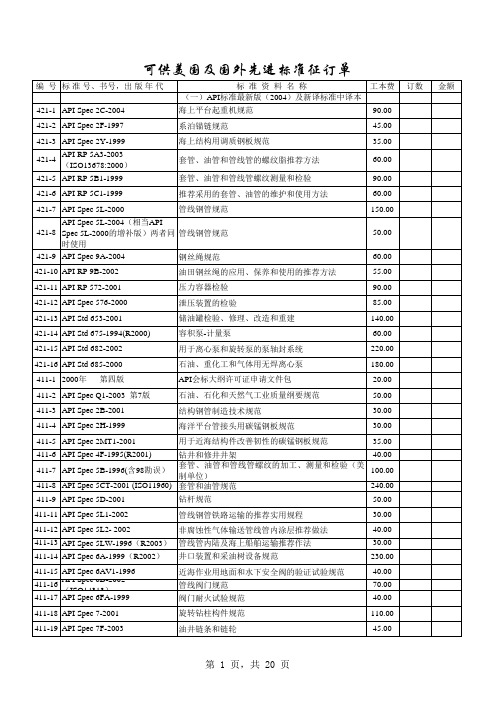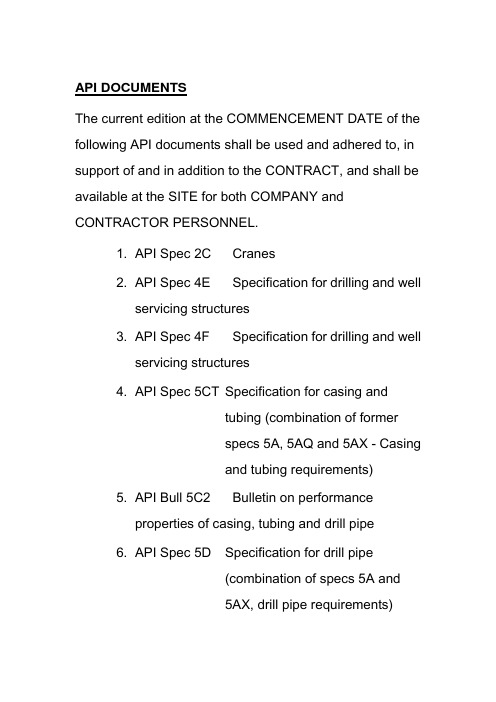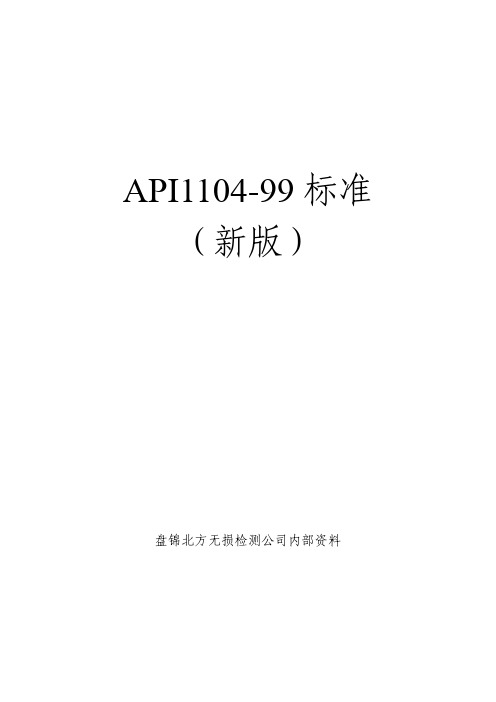20100 API 20 E
- 格式:pdf
- 大小:508.03 KB
- 文档页数:8



API DOCUMENTSThe current edition at the COMMENCEMENT DATE of the following API documents shall be used and adhered to, in support of and in addition to the CONTRACT, and shall be available at the SITE for both COMPANY and CONTRACTOR PERSONNEL.1. API Spec 2C Cranes2. API Spec 4E Specification for drilling and wellservicing structures3. API Spec 4F Specification for drilling and wellservicing structures4. API Spec 5CT Specification for casing andtubing (combination of formerspecs 5A, 5AQ and 5AX - Casingand tubing requirements)5. API Bull 5C2 Bulletin on performanceproperties of casing, tubing and drill pipe6. API Spec 5D Specification for drill pipe(combination of specs 5A and5AX, drill pipe requirements)7. API Bull 5A2 Bulletin on thread oncompounds for casing, tubing and line pipe8. API Rec RP 5A5 Recommended practice forfield inspection of new casing,tubing and plain end drill pipe 9. API Rec RP 5C1 Recommended practicefor care and use of casing and tubing10.API Spec 6A Specification for valves andwellhead EQUIPMENT11.API Spec 6D Specification for pipeline valves(steel gate, plug, ball and checkvalves)12.API Spec 7 Specification for rotary drillingEQUIPMENT13.API Spec 7B-11C Specification forinternal-combustion reciprocatingengines for oil field service14.API Spec 7F Specification for oil field chainand sprockets15.API Spec RP 7G Recommended practicefor drill stem design and operating limits16.API Spec 7J Specification for drill pipe andcasing protectors (DP CP)17.API Spec 8A Specification for drilling andproduction hoisting EQUIPMENT18.API Spec 8C Specification for drilling andproduction hoisting EQUIPMENT(PSL 1 and PSL 2)19.API Rec RP 8B Recommended practice forhoisting tool inspection andmaintenance procedures20.API Spec 9A, Specification for wire rope21.API Rec RP 9B Recommended practice onapplication, care and use of wirerope for oil field service22.API Spec 13A Specification for oil welldrilling fluid materials23.API Rec RP 13B Recommended practice forstandard procedure for fieldtesting drilling fluids24.API Bull 13C Bulletin on drilling fluidsprocessing EQUIPMENT25.API Rec RP 13E Recommended practicefor shale shaker screen cloth designation26.API Spec RP 13G Recommended practice fordrilling mud report form27.API Rec RP 13I Recommended practice,standard procedure forlaboratory testing drilling fluids 28.API Rec RP 13J Recommended practices fortesting heavy brines29.API Rec RP 49Recommended practices for safedrilling of well containinghydrogen sulphide30.API Rec RP 53Recommended practices forblow out protection EQUIPMENTsystems for drilling wells31.API Rec RP 54Recommended practices foroccupational safety and healthfor oil and gas well drilling andservicing operations32.API Rec RP 59 Recommended practices forwell control operations33.API Environment Guide Onshore Solid WasteManagement in Exploration andProduction Operations, FirstEdition34.Institute of Petroleum AreaClassification Code for Petroleum InstallationsUse of dieselengines andelectricalappliances inZone 2 area.。

API1104-99标准(新版)盘锦北方无损检测公司内部资料前言本标准是由包括美国石油学会(API)、美国气体协会(AGA)、管道承包商协会(PLCA)、美国焊接学会(AWS)、美国无损探伤学会(ASNT)的代表以及管子制造商的代表和有关工业的个人代表组成的标准编制委员会编制的。
本标准的目的是通过控制焊工资格、焊接工艺、材料和设备,焊接出高质量的焊接接头,并通过对无损检测规程、设备和无损检测人员资格的控制,以保证对焊接质量的正确评定。
本标准是非强制性的,它适用于输送原油、成品油、天然气、二氧化碳和氮气的长输管道及泵站的安装和焊接,也可用于集输和分输管网的安装和焊接。
本标准包含了油气管道设计、制造、安装和运行等方面的许多工程师的研究成果,标准编制委员会非常感谢他们真诚和有价值的帮助。
为适应技术的发展,有必要经常对本标准进行修订。
标准编制委员会始终希望收到对本标准进行改进的各种意见和建议,并将给予充分的考虑。
任何感兴趣的团体都可以对API的内容提出意见。
任何人都可以使用本标准。
目录1. 总则1.1 范围2. 引用标准3. 术语3.1 概述3.2 定义4. 焊接的一般规定4.1 设备4.2 材料5. 焊接工艺评定5.1 工艺评定5.2 记录5.3 工艺规程5.4 焊接工艺规程的变更5.5 试验管接头的焊接----对接焊5.6 焊接接头的试验----对接焊5.7 试验管接头的焊接----角焊5.8 焊接接头的试验----角焊6. 焊工资格6.1 概述6.2 单项资格6.3 全项资格6.4 外观检验6.5 破坏性试验6.6 射线探伤---只用于对接焊6.7 补考6.8 记录7. 焊接接头的设计和准备7.1 概述7.2 管口组对7.3 对接焊管口组对时对口器的使用7.4 坡口7.5 气候条件7.6 作业空间7.7 层间清理7.8 固定焊7.9 旋转焊7.10 标记7.11 预热及焊后热处理8. 焊缝的检查与试验8.1 检验权限8.2 检验方法8.3 检测人员的资格审定8.4 无损检测人员的资格证书9. 无损检测验收标准9.1 概述9.2 验收权9.3 射线探伤9.4 磁粉探伤9.5 渗透探伤9.6 超声波探伤9.7 咬边的外观检查标准10. 缺陷的清除和返修10.1 返修权限10.2 返修规程10.3验收标准10.4 监理10.5 焊工11. 无损检测规程11.1 射线探伤方法11.2 磁粉探伤方法11.3 渗透探伤方法11.4 超声波探伤方法12. 有填充金属的自动焊接12.1 适用的焊接方法12.2 工艺评定12.3 记录12.4 工艺规程12.5 焊接工艺规程的变更12.6 焊接设备和操作人员的审定12.7 记录12.8 焊缝的检验和试验12.9 无损检测验收标准12.10缺陷的清除和返修12.11射线探伤13. 无填充金属的自动焊接13.1 适用的焊接方法13.2 工艺评定13.3 记录13.4 工艺规程13.5 焊接工艺规程的变更13.6 焊接设备和操作人员的审定13.7 记录13.8 工程焊接质量保证13.9 无损检测验收标准13.10缺陷的清除和返修13.11射线探伤附录A 环焊缝的附加验收标准A.1 概述A.2 应力分析的附加要求A.3 焊接工艺A.4 焊工资格A.5 检测及验收标准A.6 记录A.7 实例A.8 返修A.9 术语附录B 管道不停输焊接B.1 概述B.2 不停输管道系统的焊接工艺评定B.3 焊工资格B.4 不停输管道系统焊接的推荐意见B.5 焊缝的检查与试验B.6 无损检测验收标准(包括外观检查)B.7 缺陷的清除和返修图1. 焊接工艺规程说明书表格形式2. 试件试验报告表格格式3. 对接接头焊接工艺评定试验的试样位置4. 拉伸试样5. 刻槽锤断试样6. 背弯和面弯试样(壁厚小于或等于12.7mm)7. 侧弯试样(壁厚大于13mm)8. 缺陷尺寸的测量9. 导向弯曲试验胎具10. 角焊焊接工艺评定及焊工资格考试刻槽锤断试样的位置11. 角焊焊接工艺评定及焊工资格考试(包括支管联接焊工资格考试)的刻槽锤断试样的位置12. 对接焊焊工资格考试试验的试样位置13. 根部未焊透14. 错边未焊透15. 中间未焊透16. 表面未熔合17. 夹层未熔合18. 根部内凹19. 气孔最大分布(壁厚≤12.7mm)20. 气孔最大分布(壁厚>12.7mm)21. API像质计22A 手工超探B型缺口22B 确定距离,折射角和速率22C 反射过程23. 闪光对焊对接接头焊接工艺评定试验的取样位置(457mm<外径≤610mm)24. 闪光对焊对接接头焊接工艺评定试验的取样位置(610mm<外径≤762mm)25. 闪光对焊对接接头焊接工艺评定试验的取样位置(外径>762mm)26. 两英寸刻槽捶断试样A-1 CTOD试验试样的取样位置A-2 CTOD试验试样加工与管壁厚关系示意图A-3 焊缝—金属试样的开缺口位置A-4 热影响区测试试样的开缺口位置A-5 环形平面缺陷的附加验收标准A-6 相干涉缺陷的评估标准A-7 厚壁管中深度缺陷的长度验收标准A-8 表面缺陷和内部缺陷的尺寸术语B-1 典型的焊道顺序实例B-2 推荐工艺和焊工评定试验部件B-3 在役焊接工艺评定试验试样的取样位置B-4 在役焊缝的宏观试验试样B-5 面弯试样B-6 加固板B-7 加固板B-8 环形套管B-9 环形三通管B-10 环形套管和板B-11 环形板表1. 填充金属分类2. 焊接工艺评定试验的试样类型及数量3. 焊工考试的对接接头试样类型及数量4. 咬边的最大尺寸5. 管壁厚与ASTM E1025规定的像质计厚度的对比6. 管壁厚与像质计厚度的对比7. 管壁厚与ASTM E747规定的线型像质计线径的对比8. 闪光对焊焊接工艺评定试验的试样类别及数量A-1 内部体积缺陷的验收标准A-2 未经返修的电弧烧伤的验收标准A-3 缺陷长度极限值A-4 实例的许用缺陷尺寸A-5 实例的平面缺陷尺寸验收A-6 管线分析实例的验收结果B-1 试验项目和试样数量管道及相关配件的焊接1. 概述1.1 范围本标准适用于使用碳钢钢管、低合金钢钢管及管件输送原油、成品油、天然气、二氧化碳和氮气等介质的长输管道、压力站管网和泵站管网的安装焊接。

美国石油学会(API)标准规范系列号标准代码描述1 API RP 500 1级1类和2类区域石油设施电气安装区域划分的推荐做法2 API RP 500B 陆上及海上固定与移动平台钻井与采油设施的电气安装区域划分的推荐做法3 API RP 505 1级0区、1区和2区石油设施电气安装区域划分的推荐做法4 API RP 520 artI 炼油厂压力释放设备的尺寸计算、选型和安装第1部分- 尺寸计算和选型5 API RP 520 artII 炼油厂压力释放设备的尺寸计算、选型和安装第2部分- 安装6 API RP 521 压力释放和泄压指南7 API STD 526 法兰钢压力释放阀8 API RP 550 炼油厂仪表和控制系统安装手册9 API RP 551 过程测量仪表10 API RP 576 压力释放设备的检查11 API STD 616 为石油、化工和气体工业服务的燃气透平12 API STD 617 为石油、化工和气体工业服务的离心压缩机13 API STD 620 大的、焊接式的低压储罐的设计和建造14 API RP 750 石油和炼油工艺危险管理15 API RP 752 与加工厂房相关的危险管理16 API RP 1104 管线和相关设施的焊接17 API RP 1111 海上碳氢管线设计、建造、操作和维护18 API STD 2000 冷冻和非冷冻低压储罐的放空19 API STD 2003 防止静电火化、闪电和漂移电流的保护措施20 API RP 14A ISO10432 井下安全阀设备规范21 API 14C 海洋石油生产平台基本表面安全系统的分析、设计、安装和试验22 API 14E 海洋石油生产平台管线系统设计和安装的推荐做法23 API 14F 非1级1类和2类区域固定和浮式海洋石油设施电气系统设计和安装的推荐做法24 API 14G 开式海洋石油生产平台防火和消防控制的推荐做法25 API 14J 海洋石油生产设施设计和安全分析的推荐做法26 API RP 2A LRFD 海上固定平台规划、设计和建造的推荐作法27 API RP 2A WSD 海上固定平台规划、设计和建造的推荐作法28 API 2G 海洋结构物上生产设施的推荐作法29 API 2I 浮式钻井单元停泊服务检测30 API 2L 海上固定平台直升机场规划、设计和建造的推荐作法31 API 2N 北极条件结构和管线规划和设计的推荐作法32 API 2X 海上结构制造超声波检查和技术员资质33 API 2Z 海上结构钢板预制资质34 API 5L8 新的绳管检测的推荐做法35 API SPEC 2B 结构钢管建造规范36 API SPEC 2C 海上吊机规范37 API SPEC 2F 系泊链条规范38 API SPEC 2H 海上平台管状节点锰钢规范39 API SPEC 2W 经过热处理的海洋结构钢板40 API SPEC 2Y 海上结构钢钢板淬火和冷却规范41 API SPEC 5L 软管规范42 API SPEC 6A 井口和管汇设备规范43 API SPEC 6D 管线阀门规范44 API SPEC 11P 石油和天然气生产服务往复压缩机规范45 API SPEC 11P 石油和天然气生产服务往复压缩机规范46 API SPEC 12B 螺栓生产液体储罐规范47 API SPEC 12D 现场焊接储液灌规范48 API SPEC 12F 运输船焊接储液灌规范49 API SPEC 12G 乙二醇气体脱水单元规范50 API SPEC 12J 石油和天然气分离器规范51 API SPEC 12K 间接型油田加热器规范52 API SPEC 12L 立式和卧式处理器规范53 API SPEC 12P 玻纤加固塑料罐规范54 API MPMS 4.1 石油计量标准手册 - 第4章校对系统第1部分 -- 介绍55 API MPMS 4.2 石油计量标准手册 - 第4章校对系统第2节 -- 管线校准试验装置56 API MPMS 4.3 石油计量标准手册 - 第4章校对系统第3节 -- 小容积计量装置57 API MPMS 4.4 石油计量标准手册 - 第4章校对系统第3节 -- 罐计量装置58 API MPMS 4.5 石油计量标准手册 - 第4章校对系统第3节 -- 主计量装置59 API MPMS 4.6 石油计量标准手册 - 第4章校对系统第3节 -- 脉冲计量60 API MPMS 4.7 石油计量标准手册 - 第4章校对系统第3节 -- 现场标准测试计量61 API MPMS 4.8 石油计量标准手册 - 第4章校对系统第3节 -- 计量系统操作62 API MPMS 5.1 石油计量标准手册 - 第5章计量第1节 -- 一般表记考量63 API MPMS 5.2 石油计量标准手册 - 第5章液体计量第2节 -- 用位移表来计量碳氢液体64 API MPMS 5.3 石油计量标准手册 - 第5章液体计量第3节 -- 用涡轮表来计量碳氢液体65 API MPMS 5.4 石油计量标准手册 - 第5章液体计量第4节 -- 用附属设备来计量液体66 API MPMS 5.5 石油计量标准手册 - 第5章液体计量第5节 -- 脉冲流量计量数据发射系统的保真度和安全性67 API MPMS 6.1 石油计量标准手册 - 第6章计量附件第1节 -- 租用自动密闭输送系统68 API MPMS 6.2 石油计量标准手册 - 第6章计量附件第2节 -- 安装架和车载非液化石油气产品计量69 API MPMS 6.5 石油计量标准手册 - 第6章计量附件第5节 -- 装卸海运散装船计量系统70 API MPMS 6.6 石油计量标准手册 - 第6章计量附件第6节 -- 管线计量系统71 API MPMS 8.1 石油计量标准手册 - 第8章采样第2节 -- 液体石油和石油产品自动采样的标准做法72 API MPMS 8.2 石油计量标准手册 - 第8章采样第2节 -- 液体石油和石油产品液体采样的混合和处理73 API MPMS 9.1 石油计量标准手册 - 第9章密度测定第1节 -- 原油和石油产品密度、相对密度(比重)或API比重的测量方法74 API MPMS 10.3 石油计量标准手册 - 第10章沉淀物和水第3节 -- 水和被离心分离过(实验室程序)的原油沉淀物的测定75 API MPMS 10.4 石油计量标准手册-第10章沉淀物和水第4节-水和/或被离心分离过(现场程序)的原油沉淀物的测定76 API MPMS 12.3 石油计量标准手册 - 第12章石油量化计算第2节 -- 来自带有原油和轻碳氢混合物的容积收缩原因77 API MPMS 14.1 石油计量标准手册 - 第14章天然气流动性测量第1节 -- 密闭传输中的天然气收集和处理78 API MPMS 14.3.1 石油计量标准手册 - 第14章天然气流动性测量第3节 -- 同心圆缺孔板计量第1部分 - 一般公式和无常指南79 API MPMS 14..3.2 石油计量标准手册 - 第14章天然气流动性测量第3节 -- 同心圆缺孔板计量第2部分 - 安装要求规范80 API MPMS 14..3.4 油计量标准手册 - 第14章天然气流动性测量第3节 -- 同心圆缺孔板计量第3部分 - 天然气应用81 API MPMS 14..3.4 石油计量标准手册 - 第14章天然气流动性测量第3节 -- 同心圆缺孔板计量第4部分 - 背景,开发,执行程序和子程序文件82 API MPMS 14..4 石油计量标准手册 - 第14章天然气流动性测量第4节 -- 天然气液体和蒸汽到同等容积的液体的质量转换83 API MPMS 14..5 来自成分分析的天然气混合物总热值、相对密度和压缩系数的计算84 API MPMS 14..6 石油计量标准手册 - 第14章天然气流动性测量第6节 -- 连续性密度测量85 API MPMS 14..7 天然气液体质量测量标准86 API MPMS 21.1 石油计量标准手册 - 第21章用于电动计量系统的流量测量第1节 --电动气体测量87 API UBL 761 勘探和生产设施的风险模型设计88 API UBL 1130 计算机管线监控89 API UBL 1149 管线参数不定性和泄露检测结果。

Minimum Yield Strength: 40,000 psiMaximum Yield Strength: 80,000 psiMinimum Tensile Strength: 60,000 psiNotes: General purpose pipe manufactured to A PI specification 5CT.Minimum Yield Strength: 55,000 psiMaximum Yield Strength: 80,000 psiMinimum Tensile Strength: 75,000 psiHardness Requirement: None Notes: General purpose pipe manufactured to A PI specification 5CT. Similar to K55 except the minimum tensile strength is low er. Usually, this grade is used in tubing applications.top of pageMinimum Yield Strength: 55,000 psiMaximum Yield Strength: 80,000 psiMinimum Tensile Strength: 95,000 psiHardness Requirement: None Notes: General purpose pipe manufactured to A PI specification 5CT. Usually, this gr ade is used in cas ingapplicationsMinimum Yield Strength: 75,000 psiMaximum Yield Strength: NoneMinimum Tensile Strength: 95,000 psiHardness Requirement: 23 HRC maximum Notes: A quenched and tempered propr ietary U. S. Steel cas ing grade for high collapse applications. Inspections are the same as for API K55 w ith hardness testing to the r equirements of API L80. Collapse testingis required for each heat and/or lot.top of pageMinimum Yield Strength: 75,000 psiMaximum Yield Strength: 90,000 psiMinimum Tensile Strength: 95,000 psiHardness Requirement: 22 HRC maximumNotes: A propr ietary U. S. Steel tubing and cas ing grade established w hen API removed C75 from the 5CT specification. Inspection and processing are in accordance w ith API grade L80.Minimum Yield Strength: 80,000 psiMaximum Yield Strength: 95,000 psiMinimum Tensile Strength: 95,000 psiHardness Requirement: 23 HRC maximumNotes: Manufactured to A PI specification 5CT. This is a controlled y ield strength material w ith a hardness testing requirement. L80 is usually used in w ells w ith sour (H2S) environments.top of pageMinimum Yield Strength: 80,000 psiMaximum Yield Strength: 110,000 psiMinimum Tensile Strength: 100,000 psiHardness Requirement: NoneNotes: General purpose pipe manufactured to A PI specification 5CT.Minimum Yield Strength: 80,000 psiMaximum Yield Strength: 110,000 psiMinimum Tensile Strength: 100,000 psiHardness Requirement: None Notes: A low er-cost alternative to standard Quench and Tempered A PI N80 (w alls less than 0.500 inch). Inspection, testing and dimens ions ar e in accordance w ith A PI 5CT for grade N80. Charpy v-notch impact testabsorbed energy results meet A PI SR16 and ar e low er than Quench a nd Tempered N80.top of pageMinimum Yield Strength: 80,000 psiMaximum Yield Strength: 95,000 psiMinimum Tensile Strength: 95,000 psiHardness Requirement: 23 HRC maximumNotes: A propr ietary controlled yield strength U. S. Steel grade generally for use in more severe sour service wells. Inspection, testing and dimensions are in accordance w ith API L80. NACE (SSC) - Method A qualification testing is required to meet a threshold stress of 90 percent of specified minimum yield strength. A PI C90couplings are used on threaded and coupled products.Minimum Yield Strength: 85,000 psiMaximum Yield Strength: 95,000 psiMinimum Tensile Strength: 95,000 psiHardness Requirement: 23 HRC maximumNotes: A propr ietary controlled yield strength U. S. Steel grade for high-collapse applications. Frequency of testing, inspection requirements and dimensional tolerances of API L80, and w ith the exception of collaps e, performance properties are based on formulae in A PI Bulletin 5C3. Collapse testing is required for each heatand/or lot.top of pageMinimum Yield Strength: 90,000 psiMaximum Yield Strength: 105,000 psiMinimum Tensile Strength: 100,000 psiHardness Requirement: 25.4 HRC maximum Notes: A PI controlled yield strength grade generally for use in sour condensate w ells. E xtensive hardness testing is required along w ith SSCC testing per NA CE Standard TM-0177-Method A. The minimum threshold stress required is 80 percent of specified minimum yield strength.Minimum Yield Strength: 90,000 psiMaximum Yield Strength: 105,000 psiMinimum Tensile Strength: 100,000 psiHardness Requirement: 24.0 HRC maximum average (26 HRC individual) Notes: P r oprietary restricted yield strength U. S. Steel grade for use in sour condensate w ells. Resistance to sulfide stress cracking is achieved by precise controls of chemical composition, heat treatment and har dness levels. Inspection requirements and dimens ional toler ances are in accordance w ith API 5CT for grade C90.Performance properties are the same as for A PI grade C90.Har dness testing is conducted as required for API C90, w ith the exception of frequency (Casing and Non-Upset Tubing - First, last and every tenth joint in betw een; Upset Tubing - First, last and every 25th joint in betw een). To reduce order lead time, sulphide stress corrosion cracking (SSCC) testing is n ot required for every order. If required by the customer, SSCC testing can be performed to U. S. Steel Standard Mill Practice P-1004 (NA CE Standard TM-0177-Method A) w ith a guar anteed minimum threshold stress of 85 percent specified minimumyield strength.top of pageeMinimum Yield Strength: 90,000 psiMaximum Yield Strength: 105,000 psiMinimum Tensile Strength: 100,000 psiHardness Requirement: 24.0 HRC maximum average (26 HRC individual) Notes: P r oprietary restricted yield strength U. S. Steel grade for use in sour condensate w ells. This product is the same as U. S. Steel C90 except impact testing is requir ed and hardness testing is done on each end ofeach joint for casing and non-upset tubing.Minimum Yield Strength: 110,000 psiMaximum Yield Strength: 140,000 psiMinimum Tensile Strength: 125,000 psiHardness Requirement: NoneNotes: P r oprietary U. S. Steel grade for high-collapse applications. Inspection, testing and dimensional tolerances are as required for API 5CT Group 3 (P110) material. With the exception of collapse, performance properties are based on for mulae in A PI Bulletin 5C3 (the 110,000 psi minimum y ield strength is an inter nalcontrol requirement, and guaranteed performance properties are based on 95,000 ps i minimum yield strength).Collapse testing is required for each heat and/or lot.top of pageeMinimum Yield Strength: 95,000 psiMaximum Yield Strength: 110,000 psiMinimum Tensile Strength: 105,000 psiHardness Requirement: 25.0 HRC maximumNotes: P r oprietary restricted yield strength U. S. Steel grade for use in sour condensate w ells. Resistance to sulfide stress cracking is achieved by precise controls of chemical composition, heat treatment and har dness levels. Inspection requirements and dimens ional toler ances are in accordance w ith API 5CT for grade T95.Performance properties are the same as for A PI grade T95.Har dness testing is conducted as required for API T95, w ith the exception of frequency (Casing and Non-Upset Tubing - First, last and every tenth joint in betw een; Upset Tubing - First, last and every 25th joint in betw een). To reduce order lead time, sulphide stress corrosion cracking (SSCC) testing is not required for every order. If required by the customer, SSCC testing can be performed to U. S. Steel Standard Mill Practice P-1004 (NA CE Standard TM-0177-Method A) w ith a guar anteed minimum threshold stress of 85 percent specified minimumyield strength.Minimum Yield Strength: 95,000 psiMaximum Yield Strength: 110,000 psiMinimum Tensile Strength: 105,000 psiHardness Requirement: NoneNotes: A PI grade w ith the same strength range as T95 and U. S. Steel C95, but w ithout a hardness requirement. This grade is not generally considered for use in sour condensate w ells since no hardness restrictions or testing is required and no SSCC testing is requir ed.top of pageMinimum Yield Strength: 95,000 psiMaximum Yield Strength: 110,000 psiMinimum Tensile Strength: 105,000 psiHardness Requirement: 25.4 HRC maximumNotes: A PI controlled y ield strength grade, the same as A PI C95 and U. S. Steel C95. Generally for use in sour condensate w ells. E xtensive hardness testing is required along w ith SSCC testing per NA CE Standard TM-0177-Method A. The minimum threshold stress required is 80 percent of specified minimum y ield strength.Minimum Yield Strength: 110,000 psiMaximum Yield Strength: 140,000 psiMinimum Tensile Strength: 125,000 psiHardness Requirement: None Notes: A PI grade for general use in deep w ells. This grade is not generally considered suitable for sourcondensate w ells.top of pageMinimum Yield Strength: 100,000 psiMaximum Yield Strength: 115,000 psiMinimum Tensile Strength: 110,000 psiHardness Requirement: 28 HRC maximumNotes: A propr ietary controlled yield strength U. S. Steel grade generally for use in deep sour service w ells.Inspection, testing and dimens ions ar e in accordance w ith A PI 5CT C90 and T95. NA CE (SSC)-Method A testing is required for each heat to meet a threshold stress of 85 percent of specified minimum yield strength.Minimum Yield Strength: 110,000 psiMaximum Yield Strength: 125,000 psiMinimum Tensile Strength: 120,000 psiHardness Requirement: 30 HRC maximumNotes: A propr ietary controlled yield strength U. S. Steel grade generally for use in deeper sour condensate wells. Inspection, testing and dimensions are in accordance w ith API T95. SSCC testing is required for each heat to meet a threshold stress of 85 percent of specified minimum yield strength.top of pageMinimum Yield Strength: 125,000 psiMaximum Yield Strength: 150,000 psiMinimum Tensile Strength: 135,000 psiHardness Requirement: No limit specified - Hardness variation requirement Notes: A PI grade for deep w ell service, not generally for use in sour condensate w ells. Quadrant hardness testing is required w ithout any spec ified limits other than the variation betw een readings. Impact testing is required for each heat and/or lot. NDT inspection is required w ith tw o methods of inspection (typically EMI andUT are perfor med on this pr oduct).Minimum Yield Strength: 125,000 psiMaximum Yield Strength: 150,000 psiMinimum Tensile Strength: 135,000 psiHardness Requirement: NoneNotes: P r oprietary U. S. Steel grade for use in deep w ell applications. This grade is a low er-cost alternative to API Q125 because tw o NDT inspections and hardness/impact testing are not required. Dimension and inspection requir ements are in accordance w ith API 5CT Group 3 mater ial.top of pageMinimum Yield Strength: 140,000 psiMaximum Yield Strength: 170,000 psiMinimum Tensile Strength: 150,000 psiHardness Requirement: None Notes: P r oprietary U. S. Steel grade for use in deep w ell applications. Dimensions and inspection are inaccordance w ith API 5CT Group 3 requirements.Minimum Yield Strength: 150,000 psiMaximum Yield Strength: 180,000 psiMinimum Tensile Strength: 160,000 psiHardness Requirement: NoneNotes: P r oprietary U. S. Steel grade for use in deep w ell applications. Dimensions and inspection are inaccordance w ith API 5CT Group 3 requirements.。
Date of Issue: February 2016Affected Publication: API Specification 6A, Specification for Wellhead and Christmas Tree Equipment, Twentieth Edition, October 2010发布日期:2016年2月受影响的规范:API 6A规范:井口和采油树设备规范,第20版,2010年10月ERRATA7 勘误表8(包括2011年1月的勘误表1;2011年11月的勘误表2;2013年6月的勘误表3;2013年8月的勘误表4、2013年11月的勘误表5以及2014年3月的勘误表6,2014年12月的勘误表7)。
第69页,7.4.2.2.12 a, 应改为:所有承压组焊焊缝和堆焊层,在全部焊接、焊后热处理和机加工完成之后,应进行100%磁粉检验(铁磁性材料)或液体渗透检验(铁磁性或非铁磁性材料)。
第87页,表30,在表的后面插入下面的注释:注释:由于附录B中注明的国际单位制转换方法,以毫米表示的通径如果用于按照USC通径尺寸制造的以英寸表示的设备可能会有差异,所以建议通径D1的测量单位应与用于测试的制造设备的单位保持一致。
第89页,7.4.9.4.5,将以下应用更改为:对于PSL 2 和PSL 3G, 以下应用:第91页将表33,更改:第91页,将表34,更改为:第96页,7.4.10.1.2 c), 第二句中的表48和表B.48应改为表61和表B61第102页, 将标题:7.4.11 管堵、阀拆卸堵和背压阀(见表26)改为:7.4.11 管堵、阀拆卸堵和背压阀(见表38)第121页,表49: 将“tol.”的法兰外径项下所列值改为“±”设定值第124页,表50: 将·“tol.”的法兰外径项下所列值改为“±”设定值第162页,表63(续),R57,将八角环(C)平面宽度从7,,79改为7,75第198页,表87(接上页)第200页,表88(接上页)第202页,图19 d), 改为下图:图示:1. 母接头 2. 压盖(格兰) 3. 堵塞 4. 公X公 5. 联接器6. 1-1/8-12 UNF-2Ba 最小深度全母螺纹b 钻孔,用于泄放,可选择,但推荐这样。
API682-2004标准分类代号API标准中,机械密封BTTFM、BTPIN等是什么意思,API标准中,机械密封BTTFM、BTPIN、BTPFN、BDPIN、BTTFN等是什么意思, 在API标准中哪儿能查到相关内容。
陈银山发表于 2010-7-20 12:36 怎么没人回答啊,自己顶一下.yllplay 发表于 2010-7-20 12:36 BTTFM字母代表的意思依次是:B 代表平衡型T代表无压得双重密封也叫串联密封T代表节流衬套F代表氟橡胶M 代表动静环分别为碳和碳化钨-2pg502 发表于 2010-7-20 12:36 BTPIN字母代表的意思依次是:B 代表平衡型T代表无压得双重密封也叫串联密封P代表普通式,不带节流衬套I代表高氟橡胶也叫全氟醚N 代表动静环分别为碳和碳化硅秋水长天发表于 2010-7-20 12:36 BTPFN字母代表的意思依次是:B 代表平衡型T代表无压的双重密封也叫串联密封P代表普通式,不带节流衬套F代表氟橡胶N 代表动静环分别为碳和碳化硅wxin 发表于 2010-7-20 12:36 BDPIN字母代表的意思依次是:B 代表平衡型D代表有压的双重密封也叫双端面密封P代表普通式,不带节流衬套I代表高氟橡胶也叫全氟醚N 代表动静环分别为碳和碳化硅FragranceM 发表于 2010-7-20 12:36 BTTFN字母代表的意思依次是:B 代表平衡型T代表无压得双重密封也叫串联密封T代表节流衬套F代表氟橡胶N 代表动静环分别为碳和碳化硅eddik 发表于 2010-7-20 12:36可以在API 610标准第八版130页查到相关内容。
cxd12345 发表于 2010-7-20 12:36 机械密封的材料和结构特点,必须根据下列分类系统来编码: 第一位字母:平衡型(B)或非平衡型(U)第二位字母:单端面(S);无压的双重密封(即第七版中称“串联密封”)(,);或有压的双重密封(即第七版中称“双端面密封”)(D)第三位字母:密封板(即密封压盖)型式(P=普通式,不带节流衬套;T=节流衬套式,设有急冷、泄露液接孔和(或)排液接孔;A=辅助密封装置,型式需加以规定)。